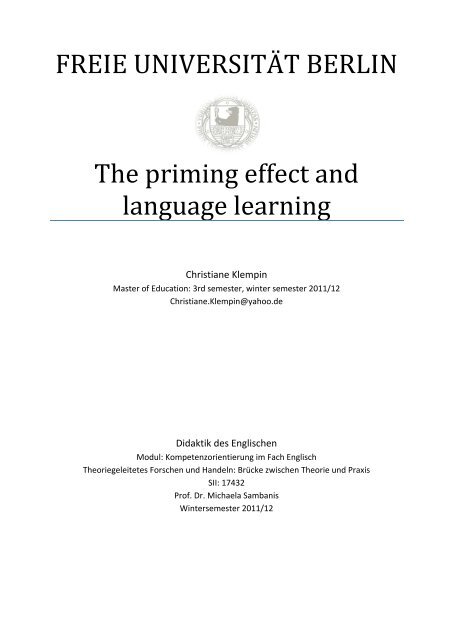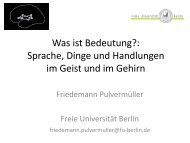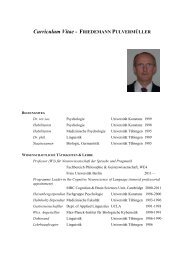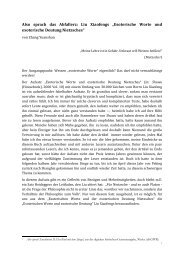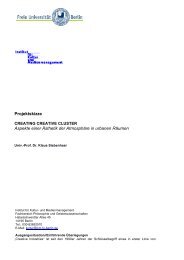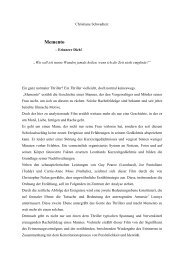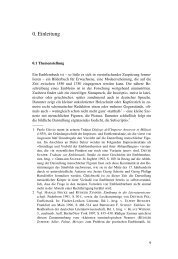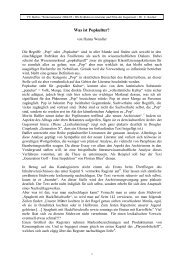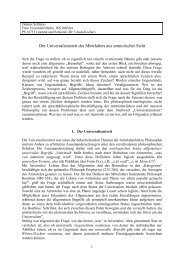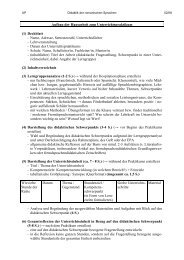3. Priming in action - Fachbereich Philosophie und ...
3. Priming in action - Fachbereich Philosophie und ...
3. Priming in action - Fachbereich Philosophie und ...
Create successful ePaper yourself
Turn your PDF publications into a flip-book with our unique Google optimized e-Paper software.
FREIE UNIVERSITÄT BERLIN<br />
The prim<strong>in</strong>g effect and<br />
language learn<strong>in</strong>g<br />
Christiane Klemp<strong>in</strong><br />
Master of Education: 3rd semester, w<strong>in</strong>ter semester 2011/12<br />
Christiane.Klemp<strong>in</strong>@yahoo.de<br />
Didaktik des Englischen<br />
Modul: Kompetenzorientierung im Fach Englisch<br />
Theoriegeleitetes Forschen <strong>und</strong> Handeln: Brücke zwischen Theorie <strong>und</strong> Praxis<br />
SII: 17432<br />
Prof. Dr. Michaela Sambanis<br />
W<strong>in</strong>tersemester 2011/12
Overview<br />
The prim<strong>in</strong>g effect and language learn<strong>in</strong>g 2<br />
1. Introduction 3<br />
2. An <strong>in</strong>troduction to the prim<strong>in</strong>g effect 4-8<br />
2.1 The location of prim<strong>in</strong>g 4-5<br />
2.2 The model prim<strong>in</strong>g experiment 5-6<br />
2.3 Variants of prim<strong>in</strong>g 6-8<br />
<strong>3.</strong> <strong>Prim<strong>in</strong>g</strong> <strong>in</strong> <strong>action</strong>: current research and<br />
didactic perspectives<br />
<strong>3.</strong>1 The prim<strong>in</strong>g effect <strong>in</strong> advertisement 8-10<br />
<strong>3.</strong>1.2 The mirror effect and Cognitive Apprenticeship as<br />
didactic perspectives of prim<strong>in</strong>g 11-12<br />
<strong>3.</strong>2. <strong>Prim<strong>in</strong>g</strong> and its effects on human self-regulation 12-14<br />
<strong>3.</strong>2.1 Didactic implications of prim<strong>in</strong>g on goal achievement 14-16<br />
<strong>3.</strong>3 Expla<strong>in</strong><strong>in</strong>g female jealousy after sublim<strong>in</strong>al prim<strong>in</strong>g<br />
with attractive and unattractive faces 16-17<br />
<strong>3.</strong><strong>3.</strong>1 Didactic perspectives of sublim<strong>in</strong>al prim<strong>in</strong>g 17-18<br />
4. Conclusion 19-20<br />
<strong>Prim<strong>in</strong>g</strong> an its didactic implications 19-20<br />
5. Bibliography 21-22
Introduction<br />
The prim<strong>in</strong>g effect and language learn<strong>in</strong>g 3<br />
“To know the true reality of yourself, you must be aware not only of your conscious<br />
thoughts, but also of your unconscious prejudices, biases and habits.” 1<br />
In the subsequent paper, I would like to illum<strong>in</strong>ate the mechanisms of prim<strong>in</strong>g as an<br />
associative activation mechanism of semantically related memory contents. 2 Additionally, I<br />
am striv<strong>in</strong>g to demonstrate the enormous potential of prim<strong>in</strong>g for the teach<strong>in</strong>g of foreign<br />
languages. Therefore, I will give an overview of the physiological and psychological processes<br />
<strong>in</strong>volved and conditions required, <strong>in</strong> order to evoke a primed response. A dist<strong>in</strong>ction<br />
between declarative and non-declarative memory of the bra<strong>in</strong> is an important prerequisite<br />
to a holistic comprehension of the prim<strong>in</strong>g processes occurr<strong>in</strong>g <strong>in</strong> the cortex. Afterwards I<br />
am also giv<strong>in</strong>g an account of the different types of prim<strong>in</strong>g and their vary<strong>in</strong>g effects on the<br />
participant. F<strong>in</strong>ally, I will <strong>in</strong>troduce the classical prim<strong>in</strong>g paradigm with its preconditions.<br />
In a second part, I will present the reader with an overview on current research that<br />
has been conducted <strong>in</strong> the field of prim<strong>in</strong>g. On the basis of an example from the real-life<br />
context (commercials), I would like to illustrate the immense sublim<strong>in</strong>al power the prim<strong>in</strong>g<br />
effect cont<strong>in</strong>ually predicates on human be<strong>in</strong>gs. Then I will proceed with academic research<br />
that has been executed for the detection of various correlations between a specific stimulus<br />
and a primed response. The first experiment by Gollwitzer and his colleagues will take a<br />
closer look at prim<strong>in</strong>g and its effects on human self-regulation. As the researchers detected a<br />
positive correlation between a pro-social prime sett<strong>in</strong>g and a low self-regulation, I will<br />
elaborate on didactic possibilities for the teach<strong>in</strong>g of languages <strong>in</strong> the heterogeneous<br />
classroom. The second experiment by Massar and Buunk will clarify the mechanisms of<br />
sublim<strong>in</strong>al prim<strong>in</strong>g and will additionally strive to expla<strong>in</strong> female rivalry <strong>in</strong> the face of an<br />
attractive opponent as an evolutionary safety mechanism to secure sexual recreation <strong>in</strong> a<br />
stable partnership.<br />
In a conclud<strong>in</strong>g part, I am attempt<strong>in</strong>g to scaffold the f<strong>in</strong>d<strong>in</strong>gs from the experiments,<br />
<strong>in</strong> order to extract those assumptions most valuable for a potential transfer to the language<br />
classroom.<br />
1 Quotation taken from: http://th<strong>in</strong>kexist.com/quotation/to_know_the_true_reality_of_yourself-you_must_be/256894.html (accessed on<br />
03/01/12). Unfortunately, the orig<strong>in</strong>ator is unknown. Allegedly, though, the citation is authored by Carl Jung.<br />
2 Cf. Hartmut O. Häcker and Kurt-H. Stapf (eds.) (2009): Das Psychologische Wörterbuch. Bern: Hogrefe, 77<strong>3.</strong>
Ma<strong>in</strong> part<br />
2. An <strong>in</strong>troduction to the prim<strong>in</strong>g effect<br />
The prim<strong>in</strong>g effect and language learn<strong>in</strong>g 4<br />
2.1 The location of prim<strong>in</strong>g: declarative and non-declarative memory<br />
Our bra<strong>in</strong> processes <strong>in</strong>formation based on experiences <strong>in</strong> two spheres. Whereas the<br />
declarative memory is divided <strong>in</strong>to an episodic (personal experiences and events) and a<br />
semantic memory section (semantic, symbolic and iconic contents) and consciously activates<br />
and processes memories 3 , the non-declarative memory is organized via prim<strong>in</strong>g events.<br />
<strong>Prim<strong>in</strong>g</strong> (to prime=to prepare, to <strong>in</strong>struct <strong>in</strong> advance) constitutes a cognitive<br />
phenomenon that can be predicated on the establishment of context-based associations<br />
between a stimulus and a response. Hence, prim<strong>in</strong>g and its modes of operation resemble the<br />
mechanisms of classical condition<strong>in</strong>g, where<strong>in</strong> a previously presented stimulus (the prime)<br />
cues a response as soon as an associated prime (then called target) is presented to the<br />
subject at a second test run. By def<strong>in</strong>ition, prim<strong>in</strong>g orig<strong>in</strong>ates <strong>in</strong> an associative l<strong>in</strong>k between<br />
two events, whereby an event A <strong>in</strong>creases the probability of the occurrence of an event B . 4<br />
The prim<strong>in</strong>g effect describes the circumstance that the “prior exposure to a stimulus<br />
(prime) can facilitate its subsequent identification and classification (target)” 5 , as the various<br />
process<strong>in</strong>g stages that were required to select that response dur<strong>in</strong>g its first presentation are<br />
bypassed. For this reason, Karl Lashley, a Harvard neuropsychologist, who studied the<br />
formation and storage of memory, paraphrased prim<strong>in</strong>g as the “subthreshold activation of a<br />
system of related associations ”6 <strong>in</strong> the human bra<strong>in</strong>. In contrast, Rickheit, Sichelschmidt and<br />
Strohner emphasized the impact of a prior prime <strong>in</strong> terms of response speed on subsequent<br />
re<strong>action</strong>s. 7 S<strong>in</strong>ce a context-related, timely restricted prime establishes certa<strong>in</strong> mental<br />
representations <strong>in</strong> the subject’s bra<strong>in</strong>, a set of associations is saved <strong>in</strong> the cortex exert<strong>in</strong>g an<br />
impact on the process<strong>in</strong>g of a subsequent target-stimulus. However, the associative pattern<br />
is not consciously saved <strong>in</strong> the non-declarative memory, which renders the <strong>in</strong>formation<br />
passive and uncontrollable for the <strong>in</strong>dividual. Research has illustrated that a repeated<br />
3<br />
Cf. Eva Breuer (2009): Effektives prozedurales Lernen: Der prädikative Wert der Sättigung früher Lerneffekte (<strong>Prim<strong>in</strong>g</strong>) für die prozedurale<br />
Gedächtniskonsolidierung. Dissertation: Charité Berl<strong>in</strong>, 7.<br />
4<br />
See Häcker and Stapf 2009, 772.<br />
5<br />
Allan Horner and Richard J. Henson (2008): “<strong>Prim<strong>in</strong>g</strong>, response learn<strong>in</strong>g and repetition suppression.” In. Neuropsychologia 46.7, 1.<br />
6<br />
Karl S. Lashley (1950): “In search of the engram.” In. James A. Anderson and Edward Rosenfeld (eds.): Neurocomput<strong>in</strong>g. Fo<strong>und</strong>ations of<br />
Research. Cambridge: MIT Press, 6<strong>3.</strong> Onl<strong>in</strong>e Resource: http://m<strong>in</strong>d.cog.jhu.edu/faculty/smolensky/050.326-<br />
626/Fo<strong>und</strong>ations%20Read<strong>in</strong>gs%20PDFs/Lashley-1950-Engram.pdf (accessed on: 15/04/2012).<br />
7<br />
Cf. Gert Rickheit; Lorenz Sichelschmidtand Hans Strohner (2002): Psychol<strong>in</strong>guistik. Stauffenburg, 42.
The prim<strong>in</strong>g effect and language learn<strong>in</strong>g 5<br />
presentation of the prime (target) assists <strong>in</strong> the acceleration of the previously tra<strong>in</strong>ed<br />
stimulus-specific re<strong>action</strong>. 8 <strong>Prim<strong>in</strong>g</strong>, such as perceptual learn<strong>in</strong>g, is located <strong>in</strong> the neocortex<br />
of our bra<strong>in</strong>. 9 In contrast to the declarative memory, <strong>in</strong>formation saved <strong>in</strong> the non-<br />
declarative section is not subject to conscious retrieval and activation. Therefore, a re<strong>action</strong><br />
triggered by a prime is observable exclusively and extremely <strong>in</strong>flexible and unpredictable, as<br />
the target is ultimately and closely l<strong>in</strong>ked to a specific context. 10 Nevertheless, the fact that<br />
prim<strong>in</strong>g can contribute to a facilitated and more precise process<strong>in</strong>g, perception and<br />
identification of a stimulus, may be of enormous value for educational purposes, as it may<br />
<strong>in</strong>crease the learn<strong>in</strong>g speed and growth, as well as positively <strong>in</strong>fluence a learner’s motivation<br />
on a certa<strong>in</strong> task.<br />
<strong>Prim<strong>in</strong>g</strong> is not only a cognitive phenomenon reverberat<strong>in</strong>g the subconscious<br />
<strong>in</strong>formation process<strong>in</strong>g and its effects on the bra<strong>in</strong>, but is also implemented as a tool <strong>in</strong><br />
cognitive science, psychology and psychol<strong>in</strong>guistics. In these discipl<strong>in</strong>es prim<strong>in</strong>g functions as<br />
a methodology render<strong>in</strong>g sublim<strong>in</strong>al mental processes visible and thus, enabl<strong>in</strong>g a thorough<br />
scientific <strong>in</strong>vestigation. 11 Hence, <strong>in</strong> the subsequent termpaper, I am not only go<strong>in</strong>g to<br />
<strong>in</strong>troduce classical prim<strong>in</strong>g experiments, but also deviations from the prim<strong>in</strong>g archetype that<br />
may be of relevance for the educational realm. Additionally, <strong>in</strong> a second part, I am also<br />
elaborat<strong>in</strong>g on various implementations of prim<strong>in</strong>g <strong>in</strong> the classroom context.<br />
2.2 The model prim<strong>in</strong>g experiment<br />
A classical prim<strong>in</strong>g experiment comprises two sessions. In a first meet<strong>in</strong>g, subjects are<br />
confronted with a stimulus, the so-called prime. In a subsequent session, the test person is<br />
offered a target stimulus related to the <strong>in</strong>itial prime by association or resemblance.<br />
Researchers then, measure the extent to which the prime has <strong>in</strong>fluenced the process<strong>in</strong>g of<br />
the target. The performance difference detected (process<strong>in</strong>g speed, response speed,<br />
concentration span, accuracy), determ<strong>in</strong>es the extent of the prim<strong>in</strong>g effect. 12<br />
In accordance with their key function with<strong>in</strong> the experimental design, a prim<strong>in</strong>g<br />
impulse takes on different forms. Past research has illustrated that for an <strong>in</strong>vestigation <strong>in</strong>to<br />
semantic or lexical prim<strong>in</strong>g, pseudo-words are of great value, as they are able to elim<strong>in</strong>ate<br />
confo<strong>und</strong><strong>in</strong>g variables. Furthermore, pseudo-words are valuable for the abolition of<br />
8<br />
Cf. http://campus.ph.fhnw.ch/pub/Music/ProjektplatformJKDSPK/<strong>Prim<strong>in</strong>g</strong>_referat.pdf (access date: 15.02.2012).<br />
9<br />
Cf. Breuer 2009, 10.<br />
10<br />
Cf. Ibid., 8.<br />
11<br />
Cf. Ingrid Scharlau; Ulrich Ansorge and Odmar Neumann (2003). „Reaktionszeitmessung: Gr<strong>und</strong>lagen <strong>und</strong> Anwendungen.“ In. G. Rickheit,<br />
T. Herrmann & W. Deutsch (ed.): Psychol<strong>in</strong>guistik. E<strong>in</strong> <strong>in</strong>ternationales Handbuch. Berl<strong>in</strong>: de Gruyter, 2<strong>3.</strong><br />
12<br />
Cf. Breuer 2009, 11 as well as Rickheit, Sichelschmidt <strong>und</strong> Strohner 2002, 42.
The prim<strong>in</strong>g effect and language learn<strong>in</strong>g 6<br />
subconscious expectations <strong>in</strong> the subject or the entire experimental group. Most<br />
significantly, however, the size of the prim<strong>in</strong>g effect is determ<strong>in</strong>ed by the specificity of the<br />
prime employed. A variation of the surface characteristics of a stimulus thus, has great<br />
impact on how the impulse is perceived, processed and stored by the participant. For<br />
<strong>in</strong>stance, experimenters fo<strong>und</strong> evidence to conclude that <strong>in</strong> terms of language prim<strong>in</strong>g, the<br />
size, font and typography of a semantic chunk, significantly affects the prim<strong>in</strong>g impact.<br />
Therefore, scientists recommend a relatively constant prime that rema<strong>in</strong>s stable <strong>in</strong><br />
appearance throughout the experimental repetition sessions. 13<br />
2.3 Variants of prim<strong>in</strong>g<br />
So far, researchers have detected six variants of prim<strong>in</strong>g. As Gollwitzer postulates, concept<br />
prim<strong>in</strong>g (direct prim<strong>in</strong>g)” causes people to act <strong>in</strong> l<strong>in</strong>e with activated concepts” 14 or<br />
categories, such as ‘beautiful’, ‘rich’ or ‘slow’. Expos<strong>in</strong>g a participant to a strong 15 semantic<br />
prime, such as ‘elderly’, Bargh, Chen and Burrows observed that those participants <strong>in</strong> the<br />
experimental group (primed with the concept of ‘elderly’) significantly differed <strong>in</strong> their<br />
walk<strong>in</strong>g speed from those, who were not subject to prior semantic prim<strong>in</strong>g. 16 Hence, the<br />
concept ‘elderly’ functioned as a semantic prime caus<strong>in</strong>g those subjects exposed to it reduce<br />
their pace. In another concept prim<strong>in</strong>g sett<strong>in</strong>g, subjects were exposed to a list of words<br />
required to be organized <strong>in</strong> such a way that they would co<strong>in</strong> a grammatically correct, as well<br />
as lexically and semantically mean<strong>in</strong>gful unit. The test conducted <strong>in</strong> such studies is called<br />
“Scrambled Sentence Test”. 17 Another method would ask participants to f<strong>in</strong>d hyper- or<br />
hyponyms to a prime (e.g. eagle/parrot/dove-bird), <strong>in</strong> order to categorize and contextualize<br />
the prime word with<strong>in</strong> a certa<strong>in</strong> mental field that subsumes related words <strong>in</strong> a lexical field <strong>in</strong><br />
our non-declarative memory of the neocortex. 18<br />
In contrast, sequential prim<strong>in</strong>g <strong>in</strong>vestigates <strong>in</strong>to the artificial connection between<br />
two mentally stored representations. Therefore, a prime is presented to the test person,<br />
which ultimately activates certa<strong>in</strong> associations <strong>in</strong> the subject. As soon as the <strong>in</strong>itial prime is<br />
13<br />
Cf. ibid., 1<strong>3.</strong> The assumption was made by Breuer <strong>in</strong> accordance with the f<strong>in</strong>d<strong>in</strong>gs of Wiggs and Mart<strong>in</strong>, 1998; Tulv<strong>in</strong>g and Schacter, 1990;<br />
Jacoby and Dallas, 1981; Biedermann and Cooper, 1991 and Jacoby and Hayman, 1987.<br />
14<br />
Gollwitzer et. al. 2011, 901.<br />
15<br />
I refer to a “strong” semantic prime, as I would like to clarify that a prime needs to meet various criteria, <strong>in</strong> order to trigger a desired<br />
target response. Thus, the prime needs to be carefully selected on gro<strong>und</strong>s of its hierarchy and effect strength with<strong>in</strong> the lexical network.<br />
Only if the prime is connected to a variety of concepts and associations <strong>in</strong> our neocortex, it will also cue the response aimed at by the<br />
researcher. For further <strong>in</strong>formation on the theory of activation spread see: Coll<strong>in</strong>s and Loftus 1975.<br />
16<br />
Gollwitzer here relates to a study conducted <strong>in</strong> 1996. Cf. Gollwitzeret. al. 2011, 901.<br />
17<br />
Cf. http://www.uni-hamburg.de/fachbereiche-e<strong>in</strong>richtungen/fb16/psych_1/Prime_referat.pdf (accessed on: 02/15/12), slide 7.<br />
18<br />
Cf. Sichelschmidt and Vorwerg 2005, 47.
The prim<strong>in</strong>g effect and language learn<strong>in</strong>g 7<br />
repeatedly presented to the participant, the response rate to the impulse significantly<br />
<strong>in</strong>creases.<br />
Sublim<strong>in</strong>al prim<strong>in</strong>g is a sort of prim<strong>in</strong>g dependent on three pr<strong>in</strong>ciples. Firstly, the<br />
stimulus presented must be conceived subconsciously by the subject. Furthermore, the<br />
prime needs to be <strong>in</strong>troduced for a very short period of time only. Additionally, <strong>in</strong> order to<br />
guarantee a sublim<strong>in</strong>al perception of the stimulus, the prime needs to be masked by an<br />
utterly red<strong>und</strong>ant and content-free impulse. Eventually, the experimenter is also required to<br />
test whether the test person has, despite the precautions taken, detected the prime. In case,<br />
the subject should have done so, the data needs to be elim<strong>in</strong>ated and not taken <strong>in</strong>to account<br />
<strong>in</strong> the evaluative part of the research.<br />
In a supralim<strong>in</strong>al prim<strong>in</strong>g sett<strong>in</strong>g, the subjects are confronted with a prime while<br />
elaborat<strong>in</strong>g on a certa<strong>in</strong> task that demands their full attention and draws their focus away<br />
from the prime <strong>in</strong>volved. A typical prim<strong>in</strong>g experiment with a supralim<strong>in</strong>al stimulus might<br />
take the follow<strong>in</strong>g form. Participants would be required to read a text while be<strong>in</strong>g occupied<br />
with a pseudo-activity, such as <strong>und</strong>erl<strong>in</strong><strong>in</strong>g all verbs. Hav<strong>in</strong>g f<strong>in</strong>ished the activity, they would<br />
be demanded to do a completely unrelated task (e.g. evaluat<strong>in</strong>g a given scenario). In<br />
accordance with the pseudo-task, or the general tone of the text elaborated on, subjects<br />
might adapt their behavior to the semantic content of the supralim<strong>in</strong>al prime. Thus, read<strong>in</strong>g<br />
a text about a socially engaged person might later <strong>in</strong>fluence participant’s social conduct or<br />
tendency of m<strong>in</strong>d (see <strong>3.</strong>2 “<strong>Prim<strong>in</strong>g</strong> and its effects on human self-regulation”, experiment<br />
2).Compar<strong>in</strong>g supralim<strong>in</strong>al and sublim<strong>in</strong>al prim<strong>in</strong>g, one must state that for both, there exists<br />
a correlation between the size of primes presented and the extent of the prim<strong>in</strong>g effect. In<br />
general, the rule can be applied that: The more primes, the greater the effect with regard to<br />
susta<strong>in</strong>ability and <strong>in</strong>tensity. Although sublim<strong>in</strong>al prim<strong>in</strong>g might often lead to less stronger<br />
outcomes than supralim<strong>in</strong>al prim<strong>in</strong>g, the former significantly reduces the risk of prime<br />
detection by the test person.<br />
Semantic prim<strong>in</strong>g (<strong>in</strong>direct prim<strong>in</strong>g) potentially bears enormous significance for the<br />
educational context, as response rates to a target can be <strong>in</strong>creased via prior presentation of<br />
semantically related primes. This phenomenon can be expla<strong>in</strong>ed with regard to the<br />
spread<strong>in</strong>g-activation theory by Coll<strong>in</strong>s and Loftus. 19 Accord<strong>in</strong>g to them, a “prime word<br />
automatically activates its representation <strong>in</strong> the lexical network.” 20 Thus, activat<strong>in</strong>g a lexical<br />
network via a semantic prime releases and triggers the capacities of the entire set of<br />
19<br />
Cf. Allan M. Coll<strong>in</strong>s and Elizabeth F. Loftus (1975): “A spread<strong>in</strong>g activation theory of semantic process<strong>in</strong>g.“ In. Psychological Review 822,<br />
407-428.<br />
20<br />
Mika Koivisto and AnttiRevonsuo (2000): „Semantic prim<strong>in</strong>g by pictures and words <strong>in</strong> the cerebral hemispheres.” In. Cognitive Bra<strong>in</strong><br />
Research 10, 91.
The prim<strong>in</strong>g effect and language learn<strong>in</strong>g 8<br />
connections and their representations. Semantic prim<strong>in</strong>g, hence, facilitates the process<strong>in</strong>g of<br />
words <strong>in</strong> the bra<strong>in</strong>, as an activation of the lexical network occurs, which ultimately leads to a<br />
spread-over effect to prime-related entries. 21 Nevertheless, one must admit that the<br />
activation impact <strong>in</strong>creases or decreases respective of the strength of a connection between<br />
different semantic units. Due to particular parameters, the impact may significantly vary <strong>in</strong><br />
its strength. As Pr<strong>in</strong>z and Bridgeman suggest, a target is recognized faster and more reliably<br />
when target and prime orig<strong>in</strong>ate from a shared category (e.g. the lexical chunk “parrot”<br />
primes a fast response for the target “dove”). 22 Hence, the more unrelated prime and target,<br />
the less strong the semantic prim<strong>in</strong>g effect will be, as the threshold will not be reached as<br />
<strong>und</strong>isrupted and immediate. The target automatically will not be recognized that fast, <strong>in</strong><br />
turn, reduc<strong>in</strong>g the impact of the <strong>in</strong>itial prime on the lexical field. Therefore, a researcher<br />
needs to <strong>in</strong>vest effort <strong>in</strong> the selection of an appropriate prime for the trigger<strong>in</strong>g of a<br />
particular target.<br />
<strong>3.</strong> <strong>Prim<strong>in</strong>g</strong> <strong>in</strong> <strong>action</strong>: Current research and its didactic<br />
perspectives<br />
<strong>3.</strong>1 The prim<strong>in</strong>g effect <strong>in</strong> advertisement<br />
Commercials and their effect on food consumption<br />
In human relations and everyday communication prim<strong>in</strong>g is an effective tool to generate an<br />
<strong>in</strong>timate relationship between two speakers. Perform<strong>in</strong>g an <strong>action</strong> yourself, but even more,<br />
observ<strong>in</strong>g someone perform<strong>in</strong>g an <strong>action</strong> activates mirror neurons <strong>in</strong> the ”premotor and<br />
parietal cortices of human and monkey bra<strong>in</strong>s.” 23 Accord<strong>in</strong>g to Carol<strong>in</strong>e Catmur and her<br />
scientific colleagues, this <strong>in</strong>terrelation has enabled human be<strong>in</strong>gs not only to establish a<br />
society based on <strong>und</strong>erstand<strong>in</strong>g, but also to develop an <strong>in</strong>tricate language system, moral<br />
values and a complex scheme of legal regulations and restrictions. 24 Despite its overall<br />
positive impact on human <strong>in</strong>ter<strong>action</strong>s, the mirror effect entails some sort of manipulative<br />
power. Mirror<strong>in</strong>g an agent’s conduct ultimately, albeit sublim<strong>in</strong>ally communicates sympathy<br />
on the side of the operator. Hence, the person re-enact<strong>in</strong>g evolves vulnerable to the<br />
21<br />
Cf. Koivisto and Revonsuo 2000, 91.<br />
22<br />
Cf. Wolfgang Pr<strong>in</strong>z and Bruce Bridgeman (eds.): „Wahrnehmung“. In. Niels Bierbaumer and Dieter Frey (eds.): Enzyklopädie der<br />
Psychologie. section C, 2. 1, 425.<br />
23<br />
Carol<strong>in</strong>e Catmur; V<strong>in</strong>cent Walsh and Cecilia Heyes (2007): “Sensorimotor Learn<strong>in</strong>g Configures the Human Mirror System.” In. Current<br />
Biology 17.17, 1527.<br />
24<br />
Cf. Catmur et. al. 2007; 1527.
The prim<strong>in</strong>g effect and language learn<strong>in</strong>g 9<br />
communication partner. The latter may read the performer like a mirror-gett<strong>in</strong>g an unique<br />
<strong>in</strong>sight <strong>in</strong>to his/her emotions, tendency of m<strong>in</strong>d and attitude <strong>in</strong> a particular context.<br />
Due to its prospective, the mirror effect has long left the orbit of social psychology<br />
and made its successful entry <strong>in</strong>to different doma<strong>in</strong>s of real and bus<strong>in</strong>ess life. Market<strong>in</strong>g<br />
professionals have recognized the enormous potential of the phenomenon for the<br />
development of improved sales strategies and for the assessment of applicants <strong>in</strong> job<br />
<strong>in</strong>terviews. What is even more worthwhile consider<strong>in</strong>g is the fact that we are all<br />
subconsciously subjected to primes when watch<strong>in</strong>g television. Advertisement functions as a<br />
“real-world prime[…]” 25 to the human subconscious, just as sensory stimuli <strong>in</strong>fluence our<br />
eat<strong>in</strong>g habits. Psychologists assume that media images may convey messages allegedly<br />
prim<strong>in</strong>g certa<strong>in</strong> behaviors <strong>in</strong> the viewer.<br />
In l<strong>in</strong>e with this stipulation, Harris, Bargh and Brownell hypothesized that “exposure<br />
to food advertisement dur<strong>in</strong>g TV view<strong>in</strong>g may […] contribute to obesity by trigger<strong>in</strong>g<br />
automatic snack<strong>in</strong>g of available food.” 26 Obesity is a major issue not only <strong>in</strong> the US, where<br />
the study took place, but also <strong>in</strong> other <strong>in</strong>dustrialized countries worldwide. Based on this<br />
observation, Harris and his colleagues assumed a partial correlation between the obesity<br />
crisis <strong>in</strong> the US and media images promot<strong>in</strong>g unhealthy food, irregular eat<strong>in</strong>g habits and<br />
display<strong>in</strong>g nutrition as fun. 27 In order to <strong>in</strong>vestigate <strong>in</strong>to this potential l<strong>in</strong>k, the researchers<br />
conducted two experiments to demonstrate the power of food advertis<strong>in</strong>g on elementary<br />
school children and adults likewise. In a first study, 118 school-aged children (56 girls and 62<br />
boys randomly assigned to a group) watched a cartoon that either conta<strong>in</strong>ed food<br />
advertisement (experimental group), or other types of advertisement (control group). The<br />
participants also received a snack (large bowl of crackers) and were told that they could have<br />
a snack while watch<strong>in</strong>g the cartoon. The experimenter left the child alone and returned<br />
when the screen<strong>in</strong>g was f<strong>in</strong>ished. The participant was asked when he had last eaten<br />
someth<strong>in</strong>g prior to snack<strong>in</strong>g. Afterwards the rema<strong>in</strong><strong>in</strong>g crackers were weighed by the<br />
experimenter and the amount was neatly recorded. In sum, the study verified Harris’,<br />
Bargh’s and Brownell’s <strong>in</strong>itial postulation that food advertisement promot<strong>in</strong>g a fun image of<br />
unhealthy nutrition, <strong>in</strong>creases food consumption <strong>in</strong> young viewers. Indeed, those children,<br />
who watched the cartoon with food commercials “ate considerably more (45%)” 28 than<br />
those <strong>in</strong> the control group regardless of their <strong>in</strong>dividual properties such as weight status,<br />
gender, age, ethnicity or social backgro<strong>und</strong>.<br />
25<br />
Jennifer L. Harris; John A. Bargh and Kelly D. Brownell (2009): “<strong>Prim<strong>in</strong>g</strong> effects of television food advertisement on eat<strong>in</strong>g behavior.” In.<br />
Health Psychology 28.4, 405.<br />
26<br />
Harris et. al. 2009, 404.<br />
27<br />
Cf. ibid., 404.<br />
28<br />
Cf. ibid., 407.
The prim<strong>in</strong>g effect and language learn<strong>in</strong>g 10<br />
In a second study, the researchers not only assumed an equivalent prim<strong>in</strong>g effect of<br />
food advertisement on adults, but further speculated that the type of food commercial<br />
determ<strong>in</strong>es the size of the prim<strong>in</strong>g effect. Therefore, they dist<strong>in</strong>guished two types of food<br />
commercials. Whereby advertisement emphasiz<strong>in</strong>g the fun factor of unhealthy food was<br />
speculated to have a negative effect on the viewer’s evaluation and consumption of food,<br />
commercials promot<strong>in</strong>g “nutrition benefits” 29 were considered to prime responsible food<br />
treatment <strong>in</strong> participants. Additionally, the research team assumed that the negative<br />
prim<strong>in</strong>g effect would be particularly marked for so-called “restra<strong>in</strong>ed eaters” 30 - consumers<br />
cont<strong>in</strong>ually diet<strong>in</strong>g and monitor<strong>in</strong>g their weight. For an <strong>in</strong>vestigation, 98 university students<br />
rang<strong>in</strong>g <strong>in</strong> age from 18 to 24 years (of which 39 were restra<strong>in</strong>ed and 53 unrestra<strong>in</strong>ed eaters)<br />
participated <strong>in</strong> the study. The subjects were then exposed to a comedy TV program (16<br />
m<strong>in</strong>utes <strong>in</strong> length), which <strong>in</strong>cluded eleven food commercials <strong>in</strong> total. Harris and his<br />
colleagues randomly assigned the students to three groups with vary<strong>in</strong>g types of food<br />
commercials. The first version with four commercials promoted a “snack<strong>in</strong>g message” 31 ,<br />
whereas a second advocated for a “nutrition message” 32 , and the control group did comprise<br />
four “additional nonfood commercials” 33 . All groups conta<strong>in</strong>ed seven nonfood commercials.<br />
In order to assess their hunger without draw<strong>in</strong>g attention to the fact that the study circled<br />
aro<strong>und</strong> that issue, hunger and thirst questions were <strong>in</strong>cluded <strong>in</strong> a “PANAS” 34 current mood<br />
rat<strong>in</strong>g. Hav<strong>in</strong>g watched the TV program, the participants were located to another room, <strong>in</strong><br />
which they were to rate food (i.e. 1. vegetables, 2. calorie-dense and nutrient-poor items<br />
such as cookies and chocolate, <strong>3.</strong> items with a healthy image such as multigra<strong>in</strong> tortilla chips)<br />
accord<strong>in</strong>g to its perceived health<strong>in</strong>ess. Additionally, they were told that they could test the<br />
food and eat as much they wanted. In l<strong>in</strong>e with <strong>in</strong>itial expectation, participants exposed to<br />
commercials with a ‘snack<strong>in</strong>g message’ “consumed significantly more than those, who<br />
viewed the nutrition ads” 35 , whereas the difference between the ‘nutrition message’<br />
commercial and the control group was not statistically relevant. Furthermore, it could be<br />
evidenced that restra<strong>in</strong>ed eaters and men ate more after a screen<strong>in</strong>g with fun food<br />
commercials.<br />
29 Ibid., 407.<br />
30 Ibid., 408.<br />
31 Ibid..<br />
32 Ibid..<br />
33 Ibid..<br />
34 PANAS-scales attempt to determ<strong>in</strong>e the affect situation of an <strong>in</strong>dividual person <strong>in</strong> a given context. Subjects are asked to respond<br />
questions on their current mood, whereby a positive and a negative affectivity is <strong>in</strong>dicated by certa<strong>in</strong> adjectives representative of that<br />
particular mood. The test persons are to rate their current mood on a five-level scale.<br />
35 Ibid., 409.
The prim<strong>in</strong>g effect and language learn<strong>in</strong>g 11<br />
<strong>3.</strong>1.2 The mirror effect and Cognitive Apprenticeship as<br />
didactic perspectives of prim<strong>in</strong>g<br />
The experiments conducted by Harris, Bargh and Brownell served to confirm an assumed<br />
correlation between exposure to food advertisements that promote positive images of<br />
snack<strong>in</strong>g and consumption behavior. Further, it could be displayed that a subconscious<br />
exposure to visual primes does massively blur our perception and evaluation of food on an<br />
analytic level and directly <strong>in</strong>fluences our food consumption habits. Despite this expected,<br />
albeit sober<strong>in</strong>g outcome, I would like to approach some ways how one could turn the<br />
prim<strong>in</strong>g and mirror effect <strong>in</strong>to someth<strong>in</strong>g positive <strong>in</strong> the context of teach<strong>in</strong>g a foreign<br />
language. For <strong>in</strong>stance, the mirror effect could be utilized by pedagogues to actively<br />
motivate their students. Furthermore, language teachers could model learn<strong>in</strong>g processes for<br />
their pupils, whereby the mirror effect automatically assists <strong>in</strong> the activation of cognitive<br />
structures to promote foreign language acquisition. Cognitive Apprenticeship, a subtype of<br />
situated learn<strong>in</strong>g 36 , is a didactic methodology that directly implements the ideas and<br />
<strong>und</strong>erly<strong>in</strong>g mechanisms of prim<strong>in</strong>g and the mirror effect. In this model the teacher functions<br />
as the <strong>in</strong>itiator of an <strong>action</strong>, perform<strong>in</strong>g a certa<strong>in</strong> behavior or articulat<strong>in</strong>g a particular mental<br />
scheme (e.g. teacher gives an account on his th<strong>in</strong>k<strong>in</strong>g dur<strong>in</strong>g a narrative technique analysis).<br />
In detail, what the <strong>in</strong>structor does is to externalize those cognitions (e.g. the thoughts<br />
<strong>in</strong>volved <strong>in</strong> the process of solv<strong>in</strong>g a task or strategies for cop<strong>in</strong>g with obstacles etc.) usually<br />
rema<strong>in</strong><strong>in</strong>g unarticulated. While the pedagogue performs the <strong>action</strong>, the learners are<br />
required to carefully observe the <strong>action</strong>, which ultimately fires their mirror system and<br />
activates behavioral mechanisms of imitation and mimicry. 37 One could also make an<br />
attempt by extend<strong>in</strong>g this ma<strong>in</strong>ly verbally oriented technique by a k<strong>in</strong>esthetic dimension.<br />
Accord<strong>in</strong>g to didactic theory, this would then be called “visuomotor learn<strong>in</strong>g” 38 and<br />
describes a phenomenon also valuable for an implementation <strong>in</strong>to the foreign language<br />
classroom. This methodology is based on the thesis that “observ<strong>in</strong>g other people perform an<br />
<strong>action</strong> can facilitate our execution of the same <strong>action</strong>.” 39 Consequently, teachers should<br />
ensure that group and partner sett<strong>in</strong>gs are heterogeneous with regard to the learner types<br />
and their <strong>in</strong>dividual skills, prior knowledge and most especially with view to the cognitive<br />
level. Coupl<strong>in</strong>g a perceptive and quickly learn<strong>in</strong>g pupil with a weaker one might activate the<br />
mirror system <strong>in</strong> the latter and contribute to a learn<strong>in</strong>g growth <strong>in</strong> the disadvantaged learner.<br />
36<br />
Cf. Franz E. We<strong>in</strong>ert (ed.) (1996). Psychologie des Lernens <strong>und</strong> der Instruktion. In. Bierbaumer, Nils; Frey, Dieter u.a. (eds.): Enzyklopädie<br />
der Psychologie. section D, 1.2. Gött<strong>in</strong>gen: Hogrefe, 306.<br />
37<br />
Cf. Franz E. We<strong>in</strong>ert and He<strong>in</strong>z Mandl (eds.) (1997). Psychologie der Erwachsenenbildung. In. Bierbaumer, Nils; Frey, Dieter u.a. (eds.):<br />
Enzyklopädie der Psychologie. section S, 1.4. Gött<strong>in</strong>gen: Hogrefe, 32<strong>3.</strong><br />
38<br />
Cf. Alison J. Wiggett; Matt Hudson; Steve P. Tipper and Paul E. Down<strong>in</strong>g (2011): “Learn<strong>in</strong>g associations between <strong>action</strong> and perception.<br />
Effects of <strong>in</strong>compatible tra<strong>in</strong><strong>in</strong>g <strong>in</strong> body part and special prim<strong>in</strong>g.”In. Bra<strong>in</strong> and Cognition 76, 88.<br />
39<br />
Wiggett et. al. 2011, 88.
The prim<strong>in</strong>g effect and language learn<strong>in</strong>g 12<br />
Additionally, as a pedagogue one could consider teach<strong>in</strong>g vocabularies accompanied by body<br />
movements or music.<br />
Prior to an actual realization, though, the <strong>in</strong>structor needs to ensure that the acoustic<br />
primes are positively stored <strong>in</strong> the mental map of his/her learners. Furthermore, the<br />
pedagogue has to decide on whether to present the prime prior to the actual task, <strong>in</strong> order<br />
to replicate authentic conditions of a prim<strong>in</strong>g experiment, or whether the stimulus is to set<br />
positive emotions <strong>in</strong> the students. Furthermore, it is recommended to select visual and<br />
acoustic impulses that are compatible with the vocabulary that is to be learned, otherwise<br />
there will be a risk that the prim<strong>in</strong>g effect is go<strong>in</strong>g to be dim<strong>in</strong>ished. Most significantly, what<br />
research on the mirror effect and prim<strong>in</strong>g suggests is that students need language teachers<br />
that are role models not only <strong>in</strong> terms of language proficiency, but also with regard to<br />
motivation and enthusiasm for their subject. A language teacher should not neglect the<br />
immense power of praise on students irrespective their age and maturity level. Positive<br />
enhancement can be an effective tool to trigger a desired behavior <strong>in</strong> the students, whereby<br />
acknowledgement functions as a sublim<strong>in</strong>al prime to an <strong>in</strong>creased learn<strong>in</strong>g effort and<br />
motivation.<br />
<strong>3.</strong>2 <strong>Prim<strong>in</strong>g</strong> and its effects on human self-regulation<br />
In an experimental design by Gollwitzer and his fellow researchers, prim<strong>in</strong>g was used to<br />
evoke low self-regulation <strong>in</strong> their subjects. The scientists were striv<strong>in</strong>g to <strong>in</strong>vestigate <strong>in</strong>to the<br />
degree to which their concept of the if-then plan is an effective tool for the enhancement of<br />
<strong>in</strong>hibition control. In sum, Gollwitzer and his colleagues tested “whether people can protect<br />
their ongo<strong>in</strong>g goal pursuits from antagonistic prim<strong>in</strong>g effects by us<strong>in</strong>g if-then plans” 40 , such<br />
as implementation <strong>in</strong>tentions. Eventually, they postulated that implementation <strong>in</strong>tentions,<br />
<strong>in</strong>deed, pose an <strong>in</strong>strument to support people <strong>in</strong> shield<strong>in</strong>g off disruptive forces, which were<br />
represented by either concept-, or goal-prim<strong>in</strong>g effects.<br />
For the collection of their data, the research team conducted three experiments of<br />
which I am go<strong>in</strong>g to take two <strong>in</strong>to closer consideration, as they bear relevance for the<br />
educational context. In a first session, the subjects were required to read and study a<br />
fictitious scientific article, whose content emphasized the genetic similarity between humans<br />
and animals. The researchers additionally referred to animals, which are known for their<br />
extreme slowness (e.g. slug, tortoise, hedgehog, caterpillar, and turtle). These animals<br />
functioned as primes for a desired fast response on a target stimulus. For reasons of<br />
40 Gollwitzer et. al 2011: “Self-regulation of prim<strong>in</strong>g effects on behavior.” In. Psychological Science 22.7, 902.
The prim<strong>in</strong>g effect and language learn<strong>in</strong>g 13<br />
comparison, another group of subjects read a text fore-gro<strong>und</strong><strong>in</strong>g animal exemplars of<br />
extreme speed, such as puma, cheetah, hare, horse and greyho<strong>und</strong>. Hav<strong>in</strong>g studied the<br />
texts, the participants had to identify (‘yes’ or ‘no’ responses on a computer pad), whether<br />
the presented stimuli constituted words or not. The classification tasks <strong>in</strong>cluded 50 words<br />
and 50 non-words. Specifically <strong>in</strong>terest<strong>in</strong>g about the tasks design, however, was that an<br />
implementation <strong>in</strong>tention masked by a non-word (‘avenda’) was <strong>in</strong>tegrated six times <strong>in</strong> the<br />
test<strong>in</strong>g session giv<strong>in</strong>g the participants the follow<strong>in</strong>g <strong>in</strong>struction:”And if the nonword ‘avenda’<br />
appears, then I respond especially quick!”.<br />
In l<strong>in</strong>e with their <strong>in</strong>itial expectation, “participants <strong>in</strong> the fast prime condition<br />
responded more quickly (M=951 ms) than did participants <strong>in</strong> the slow prime condition<br />
(M=1,171 ms)”. 41 More significantly, though, the <strong>in</strong>creased response speed did not have an<br />
impact on the correctness dur<strong>in</strong>g the classification of words and non-words. Furthermore, it<br />
could be concluded that if-then plans positively <strong>in</strong>fluence re<strong>action</strong> speed, despite a negative<br />
concept prim<strong>in</strong>g dur<strong>in</strong>g and prior to the task.<br />
In a second experiment, participants were to solve “simple but tedious arithmetic<br />
problems” 42 on a computer screen. Before actually start<strong>in</strong>g with the task, subjects had to<br />
write down a goal <strong>in</strong>tention (‘I will try to f<strong>in</strong>d as many correct solutions as possible!’) and an<br />
implementation <strong>in</strong>tention (‘If I get distracted, then I will concentrate on the test even<br />
more!’). Then, the arithmetic task was <strong>in</strong>terrupted by a “biographical memory task” 43 .<br />
Therefore, the entire group was divided <strong>in</strong>to a control and an experimental group. The<br />
control group was endowed with a text about Mother Teresa’s life full of charity (pro-social<br />
goal prime condition) and the other studied the life of Margaret Thatcher (neutral goal<br />
prime condition=control group). In a modified version of the biographies they had<br />
researched, the participants then had to highlight the differences between the texts.<br />
Logically, the next step was that the subjects returned to the arithmetic concentration task,<br />
but were <strong>in</strong>terrupted by an <strong>in</strong>truder, politely ask<strong>in</strong>g the participants to guide her/him the<br />
way to the office of the experimenter, who had just left the subjects a couple of m<strong>in</strong>utes<br />
ago.<br />
The research team <strong>in</strong>deed, detected a correlation between the pro-social goal prime<br />
condition (Mother Teresa) and the time subjects allowed distr<strong>action</strong>s. Thus, prim<strong>in</strong>g an<br />
<strong>in</strong>dividual with a “pro-social goal <strong>in</strong>creased disruption time” 44 , but only if subjects had not<br />
yet formed an implementation <strong>in</strong>tention. Consequently, Gollwitzer detected a positive<br />
41 Ibid., 90<strong>3.</strong><br />
42 Ibid., 90<strong>3.</strong><br />
43 Ibid..<br />
44 Ibid., 904.
The prim<strong>in</strong>g effect and language learn<strong>in</strong>g 14<br />
connection between hav<strong>in</strong>g formed an implementation <strong>in</strong>tention and reduction of<br />
disruption time. Thus, one can state that implementation <strong>in</strong>tentions are an effective means<br />
to reduce the disruption time, despite prior pro-social prim<strong>in</strong>g. This f<strong>in</strong>d<strong>in</strong>g might bear<br />
significance for students globally.<br />
As I have stated beforehand, not only children, but also juveniles and adolescents<br />
f<strong>in</strong>d it <strong>in</strong>creas<strong>in</strong>gly hard to shield off distr<strong>action</strong>s. Recent and current technical <strong>in</strong>ventions<br />
that respond to our desire to communicate with other humans, as well as an <strong>in</strong>creased<br />
global network<strong>in</strong>g are not only compet<strong>in</strong>g, but also impend<strong>in</strong>g factors <strong>in</strong> our striv<strong>in</strong>g for life-<br />
long learn<strong>in</strong>g, <strong>in</strong>tellectual development and progress. An academic book certa<strong>in</strong>ly appears<br />
less appeal<strong>in</strong>g than hav<strong>in</strong>g a chat with a friend on Twitter about the latest trends <strong>in</strong> music or<br />
media. However, Gollwitzer’s detection might assist <strong>in</strong> the reduction of concentration<br />
deficits and may contribute to the cementation of self-control.<br />
<strong>3.</strong>2.1 Didactic implications of prim<strong>in</strong>g on goal achievement<br />
Gollwitzer’s f<strong>in</strong>d<strong>in</strong>gs might have percussions upon the educational realm, as prim<strong>in</strong>g<br />
achievement goals might improve student’s performance <strong>in</strong> tasks, as well as enhance their<br />
“persistence <strong>in</strong> the face of obstacles, [and promote their] resumption rates after<br />
<strong>in</strong>terruptions”. 45 Consider<strong>in</strong>g the grow<strong>in</strong>g number of children with self-regulative<br />
deficiencies 46 accompanied by symptoms, such as an attention deficit, hyperactivity and<br />
impulsiveness, deploy<strong>in</strong>g prim<strong>in</strong>g as a means to strengthen goal striv<strong>in</strong>g, could be an<br />
effective <strong>in</strong>strument aga<strong>in</strong>st a low self-control <strong>in</strong> classrooms worldwide. Furthermore, one<br />
must regard the relatively modest costs <strong>in</strong>volved, render<strong>in</strong>g an employment of the method<br />
<strong>in</strong> the classroom quite unproblematic. For <strong>in</strong>stance, teachers could prepare material<br />
themselves and distribute it prior to a demand<strong>in</strong>g task. The material could comprise acoustic<br />
and visual stimuli, but also sublim<strong>in</strong>al semantic primes, <strong>in</strong>tegrated <strong>in</strong>to a text the students<br />
are required to read and to compare with another text. The material should be close to a<br />
real situation describ<strong>in</strong>g a context <strong>in</strong> which a person faces an obstacle and manages to<br />
overcome it by us<strong>in</strong>g implementation <strong>in</strong>tentions. The same could be conducted with visual<br />
impulses, present<strong>in</strong>g to the students pictures (e.g. a comic strip) of a character that applies<br />
an ‘if-then’ paradigm <strong>in</strong> the face of a disruptive force. The idea beh<strong>in</strong>d it is that either the<br />
story described <strong>in</strong> the text, or the comic function as a model how to cope with obstacles. As<br />
the prime needs to be masked, it shouldn’t become overt that the students have to focus on<br />
45 Ibid., 901.<br />
46 Gawrilow and his colleagues argue that approximately 2-7 per cent of all students suffer from some sort of self-regulative deficit. This<br />
would make a total number of at least one problematic student <strong>in</strong> every class. Cf. Gawrilow et.al. 2011, 41f..
The prim<strong>in</strong>g effect and language learn<strong>in</strong>g 15<br />
a certa<strong>in</strong> moral content. Therefore, a mask<strong>in</strong>g prime requires <strong>in</strong>tegration. Mask<strong>in</strong>g might<br />
potentially occur through a supplemental task ask<strong>in</strong>g the students to get the story <strong>in</strong>to the<br />
correct order or putt<strong>in</strong>g the comic strip <strong>in</strong>to a chronological order. Thus, the attention would<br />
divert from the prime, although the subjects would still need to focus on the content.<br />
Th<strong>in</strong>k<strong>in</strong>g of a real-life implementation of the f<strong>in</strong>d<strong>in</strong>gs from the second experiment, a teacher<br />
might select textual material on the basis of the prevalent mood with<strong>in</strong> the classroom. In<br />
fact, a pedagogue might reflect upon his students critically. One could possibly pose<br />
questions like these: Are my students focused today? Did they just have a sports lesson and<br />
might they be exhausted? Do they need additional motivation or relaxation? In accordance<br />
with the analysis of the class, the teacher then does have the option to select textual<br />
material that corresponds with the demands of his/her pupils. An unmotivated learner group<br />
requires different <strong>in</strong>put than a highly excited class. The former might get a text that focuses<br />
on a student-related topic or is especially excit<strong>in</strong>g, as it touches on a theme that is usually<br />
distant from the child’s reality. It would probably be also a good idea to present them with a<br />
text that <strong>in</strong>vites the learner to conduct body movements. For <strong>in</strong>stance, certa<strong>in</strong> key words <strong>in</strong><br />
the text might be associated with different exercises the students are to perform as soon as<br />
they scan the key word. This <strong>in</strong>struction would then also meet Gollwitzer’s demand for an<br />
implementation <strong>in</strong>tention as a means to regulate self-control. The latter, <strong>in</strong> contrast, might<br />
rather receive a text that emphasizes a balanced and quite atmosphere. Nevertheless, one<br />
should take care that the students are not study<strong>in</strong>g the text by themselves but actually<br />
engage an <strong>in</strong>ternalization of the concept addressed by it. Likewise <strong>in</strong> the other sett<strong>in</strong>g,<br />
certa<strong>in</strong> lexical chunks might be loaded with a particular <strong>action</strong> or exercise that might help<br />
the students to calm down and focus on what is happen<strong>in</strong>g <strong>in</strong> the classroom.<br />
Although I can relate to Gollwitzer’s research design, I do have a slight<br />
recommendation for an alteration. Instead of present<strong>in</strong>g a completed implementation<br />
<strong>in</strong>tention to the subjects dur<strong>in</strong>g the arithmetic concentration task, I would rather ask my<br />
students to co<strong>in</strong> their own formulations. This would add authenticity to the situation and<br />
would also promote student’s self-determ<strong>in</strong>acy and add to their overall confidence. Besides<br />
that, an <strong>in</strong>dividual has to tra<strong>in</strong> skills to reflect upon a situation with regard to its potential<br />
difficulties and obstacles. A critical view upon a task almost exclusively demands not only a<br />
diagnosis of obstacles, but also the development of strategies how to cope with them. The<br />
skill to predict and solve problems even before they actually occurred is a crucial human<br />
competence <strong>in</strong> today’s world.
The prim<strong>in</strong>g effect and language learn<strong>in</strong>g 16<br />
<strong>3.</strong>3 Expla<strong>in</strong><strong>in</strong>g female jealousy after sublim<strong>in</strong>al prim<strong>in</strong>g with attractive and<br />
unattractive faces<br />
<strong>Prim<strong>in</strong>g</strong> has also been employed as an explanatory tool for human behavior gro<strong>und</strong>ed <strong>in</strong><br />
evolutionary processes. Furthermore, social cognition suggests that human person judgment<br />
is easily manipulated through prior prim<strong>in</strong>g. Thus, sublim<strong>in</strong>al activation may be implemented<br />
to reduce preoccupations <strong>in</strong> the heterogeneous classroom, for a promotion of<br />
communicative exchange and a tra<strong>in</strong><strong>in</strong>g of cultural and social competencies <strong>in</strong> learners. Later<br />
on, I would like to return to this issue, <strong>in</strong> order to assess the possibilities and perspectives of<br />
sublim<strong>in</strong>al prim<strong>in</strong>g for the teach<strong>in</strong>g of foreign languages. Firstly, though, I would like to<br />
<strong>in</strong>troduce Massar’s and Buunk’s research based on the stipulation that female jealousy is an<br />
<strong>in</strong>tr<strong>in</strong>sically human trait ensur<strong>in</strong>g “genetic survival” 47 of the race. Accord<strong>in</strong>g to them, facial<br />
attractiveness of a rival automatically and thus, subconsciously triggers female aggression.<br />
Hence, <strong>in</strong>tersexual envy functions to ward off external threats and to guard an exist<strong>in</strong>g<br />
relationship, whose stability and ma<strong>in</strong>tenance is an ultimate prerequisite for sexual<br />
reproduction. This, <strong>in</strong> turn, can be related to the fact that heterosexual males tend to select<br />
a partner on gro<strong>und</strong>s of facial appearance, s<strong>in</strong>ce female attractiveness is considered an<br />
<strong>in</strong>dicator of reproductive fitness, health, as well as “<strong>in</strong>telligence, performance and<br />
adjustment <strong>in</strong> children”. 48 For an <strong>in</strong>vestigation <strong>in</strong>to an alleged correlation between<br />
attractiveness and <strong>in</strong>tersexual envy, the researchers employed a sublim<strong>in</strong>al prim<strong>in</strong>g<br />
paradigm.<br />
In the experiment, non-s<strong>in</strong>gle female participants 49 only were confronted with “pre-<br />
rated photographs of attractive and unattractive female[s]” 50 . For reasons of mask<strong>in</strong>g the<br />
actual prime the subjects received an attention-distract<strong>in</strong>g, but utterly red<strong>und</strong>ant task. They<br />
were <strong>in</strong>structed to identify the location of a fixation po<strong>in</strong>t on a computer screen (press<strong>in</strong>g a<br />
left/right key). The prim<strong>in</strong>g stimuli (unattractive/attractive face) were presented only 15<br />
times of a total of 60 experimental trials. The rema<strong>in</strong><strong>in</strong>g 45 stimuli were supplemented by<br />
geometrical shapes (circles, triangles and squares), so that the participants could by no<br />
means identify the actual prime. A mask<strong>in</strong>g picture consist<strong>in</strong>g of an unrecognizable version<br />
of the authentic prime additionally prevented confo<strong>und</strong><strong>in</strong>g variables. Additionally, <strong>in</strong>tervals<br />
47 Massar and Buunk 2010, 634.<br />
48 Massar and Buunk are referr<strong>in</strong>g to a study by Langlois et. al. <strong>in</strong> 2000, Cf. Massar and Buunk 2010, 635.<br />
49 In l<strong>in</strong>e with results from research stat<strong>in</strong>g that “facial attractiveness is of less importance to male <strong>in</strong>trasexual competition” than to female<br />
<strong>in</strong>trasexual competition, Massar and Buunk selected female subjects exclusively. Non-s<strong>in</strong>gles were selected for reasons of empathy and<br />
relatedness towards the given context. See Massar and Buunk 2010, 635.<br />
50 Massar and Buunk 2010, 635.
The prim<strong>in</strong>g effect and language learn<strong>in</strong>g 17<br />
between the stimuli altered randomly from two to seven seconds, <strong>in</strong> order to elim<strong>in</strong>ate<br />
subject’s speculation on the organization of the primes.<br />
Hav<strong>in</strong>g been sublim<strong>in</strong>ally primed with the attractive and unattractive faces,<br />
participants were asked to read an envy-evok<strong>in</strong>g scenario (scenario=couple at a party, a<br />
foreign woman approach<strong>in</strong>g the partner and flirt<strong>in</strong>g with him). They were also <strong>in</strong>structed to<br />
visualize the scene and make an attempt to take on the perspective of the female<br />
protagonist. Then they were asked how jealous they would be if this situation had occurred<br />
to them personally. Their envy level was rated on a scale rang<strong>in</strong>g from ‘not jealous at all’ (0)<br />
to ‘extremely jealous’ (100). The jealousy slider was supplemented by a “multiple adjective<br />
rat<strong>in</strong>g scale” 51 that comprised words to describe the tendency of the emotion evoked<br />
though the scenario. On a five-po<strong>in</strong>t-scale (from 0=not at all to =very strong) the subjects<br />
had to “rate how suspicious, betrayed, worried, distrustful, jealous, rejected, […]” they<br />
would feel.<br />
Indeed, <strong>in</strong> l<strong>in</strong>e with Massar’s and Bruunk’s <strong>in</strong>itial expectation, women reported<br />
significantly more jealousy after exposure to an attractive rival. This could not only be<br />
evidenced by the jealousy slider rat<strong>in</strong>g, but also with regard to the rated adjectives<br />
<strong>in</strong>dicat<strong>in</strong>g that participants felt comparatively more suspicious, jealous or worried than<br />
those, who were not exposed to an attractive female rival beforehand. Hence, Massar and<br />
Buunk fo<strong>und</strong> statistically relevant evidence for their thesis that “facial attractiveness [is not<br />
only] an important mate selection criterion for men” 52 , but also a feature women<br />
subconsciously process and react upon with rivalry and sexual envy.<br />
<strong>3.</strong><strong>3.</strong>1 Didactic perspectives of sublim<strong>in</strong>al prim<strong>in</strong>g<br />
For the teach<strong>in</strong>g of foreign languages Massar’s and Buunk’s f<strong>in</strong>d<strong>in</strong>gs might be utilized to<br />
tra<strong>in</strong> pupil’s cultural competence, which is an important precondition for an <strong>in</strong>dividual’s<br />
success <strong>in</strong> an <strong>in</strong>creas<strong>in</strong>gly <strong>in</strong>tricate globalized world. Further, it might <strong>in</strong>crease their<br />
awareness for the values of a democratic and tolerant and liberal-m<strong>in</strong>ded global society. The<br />
ability to change perspective is a crucial requirement addressed <strong>in</strong> the Berl<strong>in</strong> framework<br />
curriculum for English. 53 The read<strong>in</strong>g of literature there<strong>in</strong> is rendered an <strong>in</strong>strument to<br />
enhance student’s empathy and the ability to comprehend a protagonist. However,<br />
sublim<strong>in</strong>al prim<strong>in</strong>g can actively improve student’s skill to better relate to and reflect on<br />
51<br />
Ibid..<br />
52<br />
Ibid., 636.<br />
53<br />
Cf. Senatsverwaltung für Bildung, Jugend <strong>und</strong> Sport Berl<strong>in</strong> (Hrsg.): Der Berl<strong>in</strong>er Rahmenlehrplan für Englisch <strong>in</strong> der Sek<strong>und</strong>arstufe II.<br />
http://www.berl<strong>in</strong>.de/imperia/md/content/senbildung/unterricht/lehrplaene/sek2_englisch.pdf?start&ts=1283429333&file=sek2_englisch.pdf<br />
(accessed on04/15/2012).
The prim<strong>in</strong>g effect and language learn<strong>in</strong>g 18<br />
fictional characters and sett<strong>in</strong>gs. Additionally, strengthen<strong>in</strong>g this feature is of major<br />
importance <strong>in</strong> a multi-ethnic and highly heterogeneous classroom. Approach<strong>in</strong>g people of<br />
unfamiliar ethnic, l<strong>in</strong>guistic and cultural backgro<strong>und</strong>s without preoccupation and distrust<br />
thus, may not only create a healthier society, but may also alleviate tensions <strong>in</strong> the<br />
classroom. Also cyber mobb<strong>in</strong>g, an issue that has ga<strong>in</strong>ed broad <strong>in</strong>terest throughout recent<br />
years and which has also caused researchers of the FU Berl<strong>in</strong> to <strong>in</strong>itiate a program that tra<strong>in</strong>s<br />
adolescent’s skill to take on the perspective of someone else, <strong>in</strong> order to not only abolish,<br />
but even prevent bully<strong>in</strong>g from develop<strong>in</strong>g, can possibly be tackled by sublim<strong>in</strong>al prim<strong>in</strong>g<br />
with positive visuals on alterity, variety of the human race and ethnic treasures. For <strong>in</strong>stance,<br />
<strong>in</strong> teach<strong>in</strong>g “Landesk<strong>und</strong>e” topics, one can familiarize learners with a foreign country-its<br />
cultural diversity and historical richness.
4. Conclusion<br />
The prim<strong>in</strong>g effect and language learn<strong>in</strong>g 19<br />
In accordance with my <strong>in</strong>itial stipulation that prim<strong>in</strong>g might be an appropriate means to<br />
support the acquisition of foreign languages, I <strong>in</strong>troduced three experiments <strong>in</strong> total to<br />
illustrate the versatility and wide range of applications of prim<strong>in</strong>g not only from a theoretical<br />
angle, but also from a practical po<strong>in</strong>t of view.<br />
Firstly, I have shown that every human be<strong>in</strong>g is <strong>in</strong>fluenced and even deliberately<br />
manipulated by primed commercials. In l<strong>in</strong>e with these f<strong>in</strong>d<strong>in</strong>gs, I have attempted to<br />
emphasize the didactic potential the prim<strong>in</strong>g effect might exert on learners. There<strong>in</strong>, I<br />
particularly advocated for situated learn<strong>in</strong>g (Cognitive Apprenticeship) as a methodology to<br />
benefit from the prim<strong>in</strong>g effect <strong>in</strong> the foreign language classroom. Cognitive Apprenticeship<br />
additionally is regarded as a tra<strong>in</strong><strong>in</strong>g tool for meta-cognitive strategies, eventually lead<strong>in</strong>g to<br />
an <strong>in</strong>creased self-control and stable <strong>in</strong>hibition rate. 54 Furthermore, based on research’s<br />
f<strong>in</strong>d<strong>in</strong>gs, I would like to address the issue that language <strong>in</strong>structors necessarily need to exert<br />
a positive attitude towards the language taught. This has to do with the fact that the teacher<br />
may function as a sublim<strong>in</strong>al prime to his/her student’s motivation (e.g. via the use of voice,<br />
<strong>in</strong>tonation, attitude etc.). Thus, a pedagogue bears enormous responsibility <strong>in</strong> terms of the<br />
establishment of a susta<strong>in</strong>ed attitude towards that particular language and even more fatally<br />
languages <strong>in</strong> general. Despite the manipulative connotation prim<strong>in</strong>g takes due to its<br />
deployment <strong>in</strong> advertisement, the fact that prim<strong>in</strong>g may <strong>in</strong>fluence the direction of<br />
someone’s perception can be positively utilized <strong>in</strong> the classroom. Hav<strong>in</strong>g activated mental<br />
schemes, lexical fields, ideas or context expectations, one might not only promote to the<br />
comprehension process, but also add to the creation of a more stimulat<strong>in</strong>g work<br />
environment. Secondly, I have outl<strong>in</strong>ed experiments that were conducted by Gollwitzer and<br />
his colleagues on prim<strong>in</strong>g and its ultimate effects on human self-regulation. Thereby, it could<br />
be illustrated that social skills and cultural competencies could become subject to tra<strong>in</strong><strong>in</strong>g <strong>in</strong><br />
class. This would eventually lead to a more autonomous and self-determ<strong>in</strong>ed teacher, as<br />
pedagogues would be enabled to develop strategies for the enhancement of their student’s<br />
self-control and endurance, as well as for the abolition of attention deficits themselves. On<br />
account of, this might even prevent shortages from aris<strong>in</strong>g, as the teacher’s support would<br />
be immediate, context- and learner-oriented, as well as universal. Eventually, I reiterated<br />
studies seek<strong>in</strong>g to expla<strong>in</strong> female jealousy after sublim<strong>in</strong>al prim<strong>in</strong>g with attractive and<br />
unattractive faces. Referr<strong>in</strong>g from the studies conducted by Buunk and Massar, I stated that<br />
54 Cf. We<strong>in</strong>ert 2007, 32<strong>3.</strong>
The prim<strong>in</strong>g effect and language learn<strong>in</strong>g 20<br />
cultural awareness and competence may be supported <strong>in</strong> the foreign language classroom via<br />
sublim<strong>in</strong>al prim<strong>in</strong>g.<br />
In sum, evidence from prim<strong>in</strong>g research confirms that an associative activation (e.g.<br />
pre-read<strong>in</strong>g/watch<strong>in</strong>g/listen<strong>in</strong>g activities, such as read<strong>in</strong>g a text’s headl<strong>in</strong>e prior to read<strong>in</strong>g<br />
the text and co<strong>in</strong><strong>in</strong>g expectations and assumptions with regard to the content of the ensu<strong>in</strong>g<br />
text) is not only a motivational <strong>in</strong>strument <strong>in</strong> the classroom, but also a f<strong>und</strong>amental<br />
necessity, as it warms up the student’s knowledge about certa<strong>in</strong> “conceptual l<strong>in</strong>ks.” 55<br />
Furthermore, contextual prim<strong>in</strong>g might be a useful tool for text <strong>in</strong>terpretations.<br />
Hermeneutic tasks on literary texts often pose a challenge to many students lack<strong>in</strong>g the<br />
imag<strong>in</strong>ative power and will<strong>in</strong>gness to fill the gaps of a text with their own thoughts,<br />
experiences and beliefs. Thus, conduct<strong>in</strong>g a contextual activation prior to an <strong>in</strong>terpretation<br />
task might <strong>in</strong>crease student’s participation and enrich the discussion with a variety of<br />
op<strong>in</strong>ions. Also with regard to the tra<strong>in</strong><strong>in</strong>g of skim and scan read<strong>in</strong>g techniques, prim<strong>in</strong>g<br />
might open up new possibilities on the basis of an accelerated word recognition process.<br />
Expos<strong>in</strong>g students to a semantically or associated lexical item prior to read<strong>in</strong>g a text might<br />
help learners to not only <strong>in</strong>crease their skim and scan read<strong>in</strong>g speed (e.g. enhanced<br />
identification of key words), but also to dim<strong>in</strong>ish the overall error rate. Additionally, Manfred<br />
Spitzer summarizes that the color red actually supports the memory capacity, <strong>in</strong>creases<br />
acquisition speed and significantly dim<strong>in</strong>ishes the error rate. 56 The differentiation between<br />
red and blue also displayed the enormous motivational significance of colors. Whereas red<br />
primed avoidance, blue was fo<strong>und</strong> to activate some sort of approximation to an activity, task<br />
or object. In turn, Spitzer could f<strong>in</strong>d evidence that blue was responsible for foster<strong>in</strong>g<br />
participant’s creativity. For the future of teach<strong>in</strong>g these f<strong>in</strong>d<strong>in</strong>gs might be of great<br />
significance, as they could evolve a trigger for an <strong>in</strong>creas<strong>in</strong>gly <strong>in</strong>telligent and reasonable<br />
design and treatment of teach<strong>in</strong>g materials and exam<strong>in</strong>ation <strong>in</strong>structions.<br />
However, as far as I am concerned, my assumptions on the practical value of prim<strong>in</strong>g<br />
for the teach<strong>in</strong>g of English as a foreign language still require an academic fo<strong>und</strong>ation and<br />
data to prove an alleged relation between prim<strong>in</strong>g and an enhanced acquisition process.<br />
Conduct<strong>in</strong>g empirical studies on the didactic implications of prim<strong>in</strong>g, one might face the<br />
challenge of mask<strong>in</strong>g the prime, <strong>in</strong> order to reduce and elim<strong>in</strong>ate confo<strong>und</strong><strong>in</strong>g variables.<br />
Further, one might struggle with term<strong>in</strong>ological bo<strong>und</strong>aries, such as between prim<strong>in</strong>g,<br />
classical condition<strong>in</strong>g, model learn<strong>in</strong>g and the mirror effect, as the transition between these<br />
phenomena is quite fluid.<br />
55<br />
Günter Clauß (ed.) (1995): Fachlexikon ABC Psychologie. Das Wörterbuch der Psychologie. Frankfurt am Ma<strong>in</strong>: Verlag Harry Deutsch<br />
Thun, 358. Translation C.K..<br />
56<br />
Cf. Manfred Spitzer (2009): „Die Farben des Denkens.“ In. Nervenheilk<strong>und</strong>e 28.5, 321.
5. Bibliography<br />
Academic Articles and Secondary Sources<br />
The prim<strong>in</strong>g effect and language learn<strong>in</strong>g 21<br />
Catmur, Carol<strong>in</strong>e; Walsh, V<strong>in</strong>cent and Heyes, Cecilia (2007): “Sensorimotor Learn<strong>in</strong>g<br />
Configures the Human Mirror System.” In. Current Biology 17.17, 1527-1531.<br />
Clauß, Günter (ed.) (1995): Fachlexikon ABC Psychologie. Das Wörterbuch der Psychologie.<br />
Frankfurt am Ma<strong>in</strong>: Verlag Harry Deutsch Thun.<br />
Coll<strong>in</strong>s, A.M. and Loftus, E.F. (1975): “A spread<strong>in</strong>g activation theory of semantic<br />
process<strong>in</strong>g.“In. Psychological Review 822, 407-428.<br />
Gawrilow, Cater<strong>in</strong>a; Schmitt, Katr<strong>in</strong> and Rauch, Wolfgang (2011): „Intervention. Kognitive<br />
Kontrolle <strong>und</strong> Selbstregulation bei K<strong>in</strong>dern mit ADHS.“ In. K<strong>in</strong>dheit <strong>und</strong> Entwicklung. 20.1 ,<br />
41-48.<br />
Gollwitzer, Peter M.; Sheeran, Paschal; Trötschel, Roman and Webb, Thomas L. (2011): “Selfregulation<br />
of prim<strong>in</strong>g effects on behavior.” In. Psychological Science 22.7, 902-907.<br />
Häcker, Hartmut O.and Stapf, Kurt-H. (eds.) (2009): Das Psychologische Wörterbuch. Bern:<br />
Hogrefe.<br />
Harris, Jennifer L.; Bargh, John A. and Brownell, Kelly D. (2009): “<strong>Prim<strong>in</strong>g</strong> effects of television<br />
food advertisement on eat<strong>in</strong>g behavior.” In. Health Psychology 28.4, 404-41<strong>3.</strong><br />
Horner, Allan and Henson, Richard J. (2008): “<strong>Prim<strong>in</strong>g</strong>, response learn<strong>in</strong>g and repetition<br />
suppression.” In. Neuropsychologia46.7, 1-25.<br />
Koivisto, Mika and Revonsuo, Antti (2000): „Semantic prim<strong>in</strong>g by pictures and words <strong>in</strong> the<br />
cerebral hemispheres.” In. Cognitive Bra<strong>in</strong> Research 10, 91-98.<br />
Massar, Karlijn; Buunk, Abraham P. (2010): „Judg<strong>in</strong>g a book by its cover. Jealousy after<br />
sublim<strong>in</strong>al prim<strong>in</strong>g with attractive and unattractive faces.”In. Personality and <strong>in</strong>dividual<br />
differences 49, 634-638.<br />
Pr<strong>in</strong>z, Wolfgang and Bridgeman, Bruce (eds.): „Wahrnehmung“. In. Bierbaumer, Niels and<br />
Frey, Dieter (eds.): Enzyklopädie der Psychologie. section C, 2. 1.<br />
Rickheit, Gert; Sichelschmidt, Lorenz and Strohner, Hans(2002): Psychol<strong>in</strong>guistik. Tüb<strong>in</strong>gen:<br />
Stauffenburg.<br />
Scharlau, Ingrid; Ansorge, Ulrich and Neumann, Odmar (2003). „Reaktionszeitmessung:<br />
Gr<strong>und</strong>lagen <strong>und</strong> Anwendungen.“ In. Rickheit, Gert; et. Al. (eds.): Psychol<strong>in</strong>guistik. E<strong>in</strong><br />
<strong>in</strong>ternationales Handbuch. Berl<strong>in</strong>: de Gruyter.<br />
Spitzer, Manfred (2009): „Die Farben des Denkens.“ In. Nervenheilk<strong>und</strong>e 28.5, 320-32<strong>3.</strong>
The prim<strong>in</strong>g effect and language learn<strong>in</strong>g 22<br />
We<strong>in</strong>ert, Franz E. and Mandl, He<strong>in</strong>z (eds.) (1997). „Psychologie der Erwachsenenbildung“. In.<br />
Bierbaumer, Nils; Frey, Dieter u.a. (eds.): Enzyklopädie der Psychologie. section D, 1.4,<br />
Gött<strong>in</strong>gen: Hogrefe.<br />
We<strong>in</strong>ert, Franz E. (ed.) (1996). „Psychologie des Lernens <strong>und</strong> der Instruktion“. In.<br />
Bierbaumer, Nils and Frey, Dieter et.al. (eds.): Enzyklopädie der Psychologie. section D, 1.2,<br />
Gött<strong>in</strong>gen: Hogrefe.<br />
Wiggett, Alison J.; Hudson, Matt; Tipper, Steve P. and Down<strong>in</strong>g, Paul E. (2011): “Learn<strong>in</strong>g<br />
associations between <strong>action</strong> and perception. Effects of <strong>in</strong>compatible tra<strong>in</strong><strong>in</strong>g <strong>in</strong> body parts<br />
and special prim<strong>in</strong>g.” In. Bra<strong>in</strong> and Cognition 76, 87-96.<br />
Web Sources<br />
Unknown author-quotation from page<br />
3: http://th<strong>in</strong>kexist.com/quotation/to_know_the_true_reality_of_yourselfyou_must_be/256894.html<br />
(accessed on 03/01/12).<br />
Harris, Jennifer L.; Bargh, John A. and Brownell, Kelly D.(2009): “<strong>Prim<strong>in</strong>g</strong> Effects of Television<br />
Food Advertis<strong>in</strong>g on Eat<strong>in</strong>g Behavior.” In. Health Psychology 28.4, 404-41<strong>3.</strong><br />
http://www.yale.edu/acmelab/articles/Harris_Bargh_Brownell_Health_Psych.pdf (accessed<br />
on 03/01/12).<br />
Horner, Allan and Henson, Richard J. (2008): “<strong>Prim<strong>in</strong>g</strong>, response learn<strong>in</strong>g and repetition<br />
suppression.” In. Neuropsychologia46.7, 1-25.<br />
http://www.ncbi.nlm.nih.gov/pmc/articles/PMC2430995/pdf/ma<strong>in</strong>.pdf (accessed on<br />
03/01/12).<br />
Lashley, Karl S. (1950): “In search of the engram.” In. James A. Anderson and Edward<br />
Rosenfeld (eds.): Neurocomput<strong>in</strong>g. Fo<strong>und</strong>ations of Research. Cambridge: MIT Press.<br />
http://m<strong>in</strong>d.cog.jhu.edu/faculty/smolensky/050.326-626/Fo<strong>und</strong>ations%20Read<strong>in</strong>gs<br />
%20PDFs/Lashley-1950-Engram.pdf (accessed on: 15/04/2012).<br />
Senatsverwaltung für Bildung, Jugend <strong>und</strong> Sport Berl<strong>in</strong> (Hrsg.): Der Berl<strong>in</strong>er Rahmenlehrplan<br />
für Englisch <strong>in</strong> der Sek<strong>und</strong>arstufe II.<br />
http://www.berl<strong>in</strong>.de/imperia/md/content/senbildung/unterricht/lehrplaene/sek2_englisch<br />
.pdf?start&ts=1283429333&file=sek2_englisch.pdf (accessed on: 04/15/2012).<br />
Stangl, Werner: Arbeitsblatt zum Thema “Inhaltsabhängige Gedächtnisformen.”<br />
http://arbeitsblaetter.stangl-taller.at/GEDAECHTNIS/ModelleInhalt.shtml (accessed<br />
02/26/12).<br />
http://campus.ph.fhnw.ch/pub/Music/ProjektplatformJKDSPK/<strong>Prim<strong>in</strong>g</strong>referat.pdf (accessed<br />
on 02/15/12).


